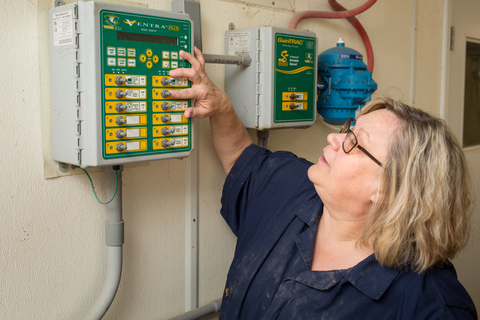Quick facts
- Ventilation removes excess heat, moisture and gas from swine barns.
- During weather changes, make sure your controller is set for proper ventilation.
- Management practices such as removing manure, cleaning and preventing dust and repairing leaking water sources can improve your ventilation efficiency.
Why do you need ventilation?
Have you ever stepped into your hog building and thought it felt like a balmy beach day on vacation, only to realize that the heater and the fans were both running full blast? Comfortable, but not at all efficient or economical.
Animals housed inside a building produce heat, gas and moisture. Their heat results from their metabolism and the larger they grow, the more heat they produce. Gas develops from stored manure. Moisture occurs from several sources in swine barns including:
- Pigs breathing (respiration).
- Drinking water spills.
- Evaporation of urine and manure.
Swine barns need ventilation to remove the excess heat, gas and moisture that buildup in the facility. Springtime is one of the most challenging in terms of keeping the pigs warm enough at night and comfortably well-ventilated during the day.
Providing ventilation in the spring
No matter what their size, during springtime weather changes pigs need to be kept dry and out of a draft. Unpredictable seasonal weather can change quickly. Adjust ventilation controllers to make certain of proper ventilation rates for removing moisture, gas and dust from the inside environment. Keep heater thermostats set to supplement the room or building with heat if the outside temperature drops.
The following tables below show recommended ventilation rates and temperatures for pigs according to their size. Reviewing these tables when setting the controllers in a swine building can help you most efficiently dry and cool or heat the environment.
Seasonal ventilation rates for swine barns
| Cold weather | Mild weather | Hot weather | |
|---|---|---|---|
| Pig weight (lbs) | Rates (CFM/hd) | ||
| 12-30 | 2 | 10 | 25 |
| 30-75 | 3 | 15 | 35 |
| 75-100 | 7 | 24 | 75 |
| 150-260 | 10 | 35 | 120 |
Table from MWPS-32, Mechanical Ventilation Systems for Livestock Housing
Recommended temperatures for swine barns
| Pig weight (lb) | Preferred temperature (F) | Lower range | Upper range |
|---|---|---|---|
| 10-30 | 80-90 | 60 | 95 |
| 30-75 | 65-80 | 40 | 95 |
| 75-150 | 60-75 | 25 | 95 |
| 150-260 | 50-75 | 5 | 95 |
Table from NPB Swine Care Handbook, Appendix Table 2
Managing facilities for efficient ventilation
Good building maintenance habits can maximize the effects of your careful controller settings.
- Repair all leaking drinker nipples and water lines to reduce moisture in the building.
- Clean up manure and urine to further reduce both humidity and ammonia in the area.
- Remove dust from ventilation equipment, controllers, fans and air inlets.
- Clean fan blades and shrouds, and check fan motors regularly to ensure dependable operation.
- To reduce the dust in the building, limit handling of feed and disturbance of the pigs.
- Adjust air inlet openings to the minimum ventilation rate to prevent excess cold air entering the building. Check to see that the inlets are not plugged with dust, snow or building materials loosened by rodents.
- Check and service heaters regularly and clean the dust out of heating units.
As the building ages, corrosion from dust, moisture or ammonia can damage control units. If you think there are inaccuracies in settings or performance, double-check it or replace it.
Evaluating ventilation needs
Pigs' body language can also tell you whether the building or room is ventilated correctly. Shivering or piled pigs are a signal to check for drafts, floor dampness, or failure of one or more parts of your ventilation system. Studies have shown that pigs who have to keep themselves warm will consume more feed but yield lower average daily gain.
Set the fan speeds and temperature in the room according to the pig's size needs, then leave it.
One case study of a breeding unit to identify the source of excess propane usage tracked changing temperatures both inside the building and outdoors. A spike in the set temperature in September alerted the researcher that the barn manager was adjusting the settings according to his own comfort after coming in from the chilly autumn outdoors.
The hogs are accustomed to fairly steady temperatures, and it's important that you don't drastically change their environment.
Reviewed in 2019


